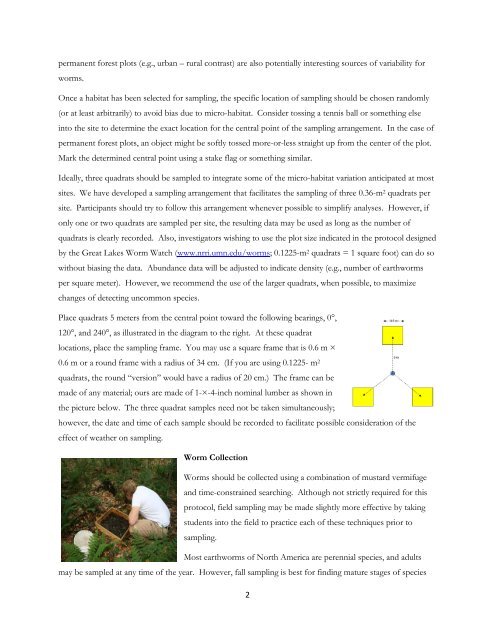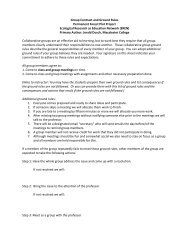EREN Worm Protocol
EREN Worm Protocol
EREN Worm Protocol
You also want an ePaper? Increase the reach of your titles
YUMPU automatically turns print PDFs into web optimized ePapers that Google loves.
permanent forest plots (e.g., urban – rural contrast) are also potentially interesting sources of variability for<br />
worms.<br />
Once a habitat has been selected for sampling, the specific location of sampling should be chosen randomly<br />
(or at least arbitrarily) to avoid bias due to micro-habitat. Consider tossing a tennis ball or something else<br />
into the site to determine the exact location for the central point of the sampling arrangement. In the case of<br />
permanent forest plots, an object might be softly tossed more-or-less straight up from the center of the plot.<br />
Mark the determined central point using a stake flag or something similar.<br />
Ideally, three quadrats should be sampled to integrate some of the micro-habitat variation anticipated at most<br />
sites. We have developed a sampling arrangement that facilitates the sampling of three 0.36-m 2 quadrats per<br />
site. Participants should try to follow this arrangement whenever possible to simplify analyses. However, if<br />
only one or two quadrats are sampled per site, the resulting data may be used as long as the number of<br />
quadrats is clearly recorded. Also, investigators wishing to use the plot size indicated in the protocol designed<br />
by the Great Lakes <strong>Worm</strong> Watch (www.nrri.umn.edu/worms; 0.1225-m 2 quadrats = 1 square foot) can do so<br />
without biasing the data. Abundance data will be adjusted to indicate density (e.g., number of earthworms<br />
per square meter). However, we recommend the use of the larger quadrats, when possible, to maximize<br />
changes of detecting uncommon species.<br />
Place quadrats 5 meters from the central point toward the following bearings, 0°,<br />
120°, and 240°, as illustrated in the diagram to the right. At these quadrat<br />
locations, place the sampling frame. You may use a square frame that is 0.6 m ×<br />
0.6 m or a round frame with a radius of 34 cm. (If you are using 0.1225- m 2<br />
quadrats, the round “version” would have a radius of 20 cm.) The frame can be<br />
made of any material; ours are made of 1-×-4-inch nominal lumber as shown in<br />
the picture below. The three quadrat samples need not be taken simultaneously;<br />
however, the date and time of each sample should be recorded to facilitate possible consideration of the<br />
effect of weather on sampling.<br />
<strong>Worm</strong> Collection<br />
<strong>Worm</strong>s should be collected using a combination of mustard vermifuge<br />
and time-constrained searching. Although not strictly required for this<br />
protocol, field sampling may be made slightly more effective by taking<br />
students into the field to practice each of these techniques prior to<br />
sampling.<br />
Most earthworms of North America are perennial species, and adults<br />
may be sampled at any time of the year. However, fall sampling is best for finding mature stages of species<br />
2




